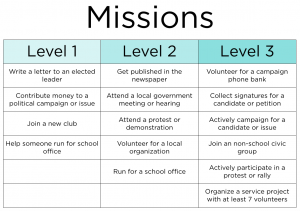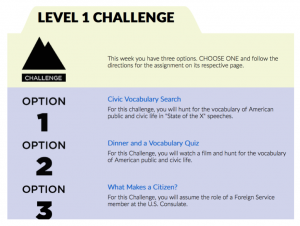Aligning students’ instructional preferences with course activities and providing opportunities for learner choice are widely recognized as educational best practice, helping students to engage with content and learn more effectively (Kern & State, 2009; Patall, Dent, Oyer, & Wynn, 2013; Patall, Cooper, & Wynn, 2010), and researchers and practitioners have started extending this instructional approach to online learning (Akdemir & Koszalka, 2008; Tonsing-Meyer, 2013). Additionally, researchers and practitioners are beginning to acknowledge that online learning does not presuppose that students learn online, using “learning experiences” as a substitute for coursework and assignments (Straumsheim, 2013; Qing & Akins, 2005). In other words, students can learn formal content for online coursework while engaging in activities away from their screens. From these two approaches, the concept of challenges and missions were born for an online civic engagement course for undergraduate students.
Link to example artifact(s)
In the online civic engagement course for undergraduate students, Rethinking Citizenship, challenges are the primary learning activity, serving as both instruction and assignments. They always require students to do something: to think about something, to explore it on their own, to build or craft or design something based upon their new understanding, and then to reflect upon what they have done. In fact, each challenge is formatted the same way across three sections—Preparation, Action, Reflection—so that students must indeed think about what they’re going to do, do it, and then think about what they’ve just done. Most importantly, students get to choose which ones they complete from a menu of options.
Missions serve as the experiential component of the course. Missions always require students to do something and they often require students to leave the house (and therefore the computer screen). Missions are ranked Level 1, Level 2, or Level 3 based on their complexity and expected time commitment. Over the course of the semester, students must complete at least three Level 1 Missions, two Level 2 Missions, and one Level 3 Mission. Perhaps more importantly, students must document which missions they complete and then submit a Reflection piece that allows them to make meaning of their experience.
When students begin a new module, they are presented with two separate menus: one for Level 1 Challenges and one for Level 2 Challenges (see image artifact). Each challenge is hyperlinked to a page on the LMS that explains all of the components of the challenge and includes an annotated table of resources and a rubric. Students select and complete their preferred challenge and then return to the menu page, which is actually an assignment page, to submit their work. Using the example provided in the PDF artifact, for the objective of evaluating public leadership styles, students would choose between a popular culture challenge and a more academic/historical challenge for Level 1 and between a more introspective challenge and a social media challenge for Level 2. Other modules and objectives offer up to four challenge choices per level.
Students are informed at the beginning of the course that they must complete a total of six missions: at least three Level 1 Missions, two Level 2 Missions, and one Level 3 Mission. On the LMS, there is a Missions page that explains the requirement and provides a menu of options (see image artifact). Students are also invited to propose mission alternatives to the instructor. Once students have completed and documented their mission and written their accompanying reflections, they return to the Missions Module where they are able to submit through one of the six assignments that are provided (again, three for Level 1 Missions, two for Level 2 Missions, and one for their Level 3 Mission).
Complete assignment instruction can be found at: File:Example Challenges Public Leadership Styles.pdf
While the provided examples are limited to the content and activities of a civics course, it should be easy to see how the approach could be adapted to any discipline, any course. All that is needed is time and creativity.
Link to scholarly reference(s)
Akdemir, O., & Koszalka, T. A. (2008). Investigating the relationships among instructional strategies and learning styles in online environments. Computers and Education, 50(4), 1451-1461.
Kern, L., & State, T. M. (2009). Incorporating Choice and Preferred Activities Into Class wide Instruction. Beyond Behavior, 18(2), 3-11.
Patall, E., Dent, A., Oyer, M., & Wynn, S. (2013). Student autonomy and course value: The unique and cumulative roles of various teacher practices. Motivation & Emotion, 37(1), 14-32.
Patall, E. A., Cooper, H., & Wynn, S. R. (2010). The effectiveness and relative importance of providing choices in the classroom. Journal of Educational Psychology, 102, 896–915.
Qing, L., & Akins, M. (2005). Sixteen myths about online teaching and learning in higher education: Don’t believe everything you hear. Techtrends: Linking Research & Practice To Improve Learning, 49(4), 51-60.
Straumsheim, C. (2013, October 28). Don’t call it a course. Inside Higher Education. Retrieved from https://www.insidehighered.com/news/2013/10/28/online-course-providers-increasingly-using-term-learning-experience
Tonsing-Meyer, J. (2013). An examination of online instructional practices based on the learning styles of graduate education students. Quarterly Review Of Distance Education, 14(3), 141-149.
Citation
Humphries, E. (2015). Use academic challenges and experiential missions to provide learner choice and engage students in online course activities. In B. Chen & K. Thompson (Eds.), Teaching Online Pedagogical Repository. Orlando, FL: University of Central Florida Center for Distributed Learning. https://topr.online.ucf.edu/use-academic-challenges-and-experiential-missions-to-provide-learner-choice-and-engage-students-in-online-course-activities/.

